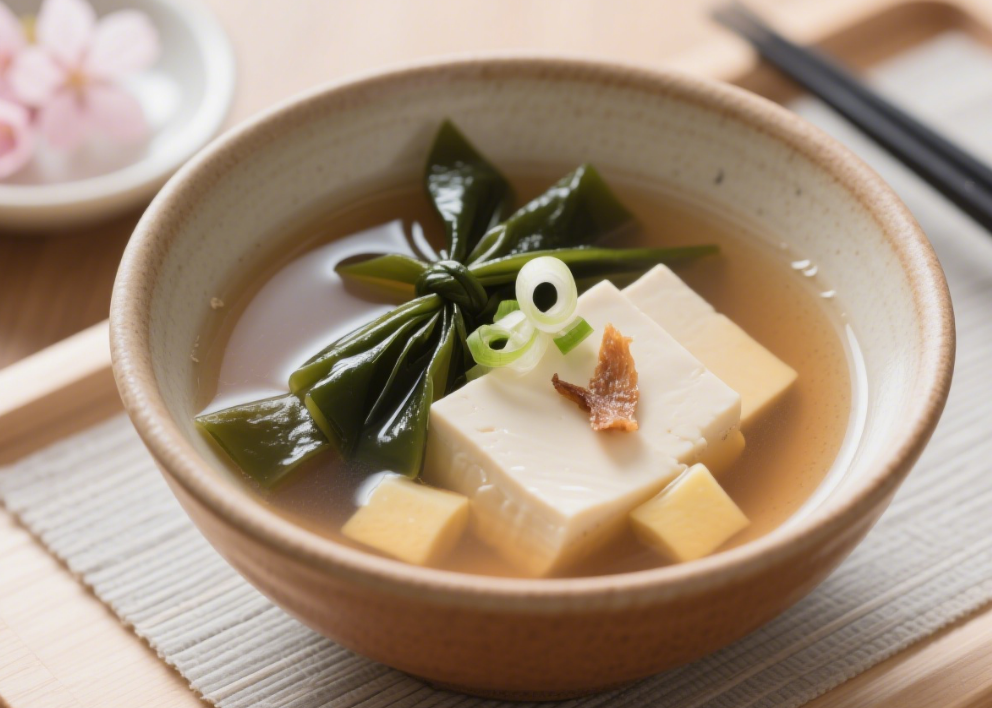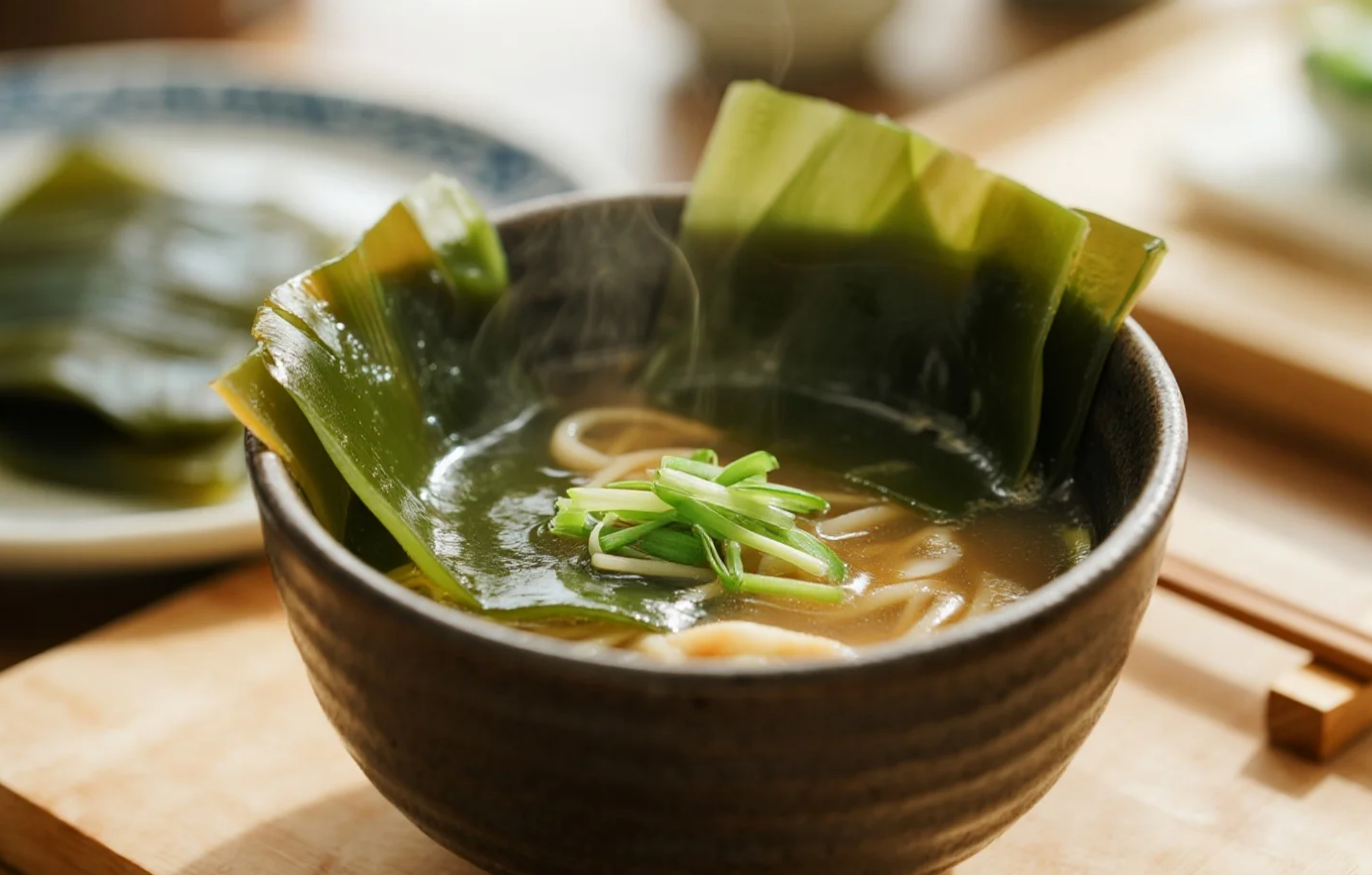In the halls of Japanese cuisine, miso, kelp, and tofu soup stands as a shining pearl, embodying the culinary wisdom of this island nation for millennia. This seemingly simple soup, from the selection of ingredients to its preparation, embodies a profound philosophy of well-being, perfectly embodying the essence of Japanese culture, where medicine and food share a common origin.
 To make an authentic miso, kelp, and tofu soup, we carefully prepare the following ingredients: 10 grams of dried kelp, soaked in cold water for 30 minutes beforehand—this is crucial for capturing the umami flavor of the ocean; 15 grams of bonito flakes, which impart a unique smoky flavor to the soup; 200 grams of soft tofu, cut into bite-sized cubes; 2 fresh shiitake mushrooms, thinly sliced to fully release their umami; 3 tablespoons of white miso, the heart of the soup base, preferably one that has been fermented for a moderate amount of time; and finally, a pinch of chopped green onions and shichimi flakes for garnish. This combination of ingredients preserves their respective flavors while creating a wonderful synergistic effect.
To make an authentic miso, kelp, and tofu soup, we carefully prepare the following ingredients: 10 grams of dried kelp, soaked in cold water for 30 minutes beforehand—this is crucial for capturing the umami flavor of the ocean; 15 grams of bonito flakes, which impart a unique smoky flavor to the soup; 200 grams of soft tofu, cut into bite-sized cubes; 2 fresh shiitake mushrooms, thinly sliced to fully release their umami; 3 tablespoons of white miso, the heart of the soup base, preferably one that has been fermented for a moderate amount of time; and finally, a pinch of chopped green onions and shichimi flakes for garnish. This combination of ingredients preserves their respective flavors while creating a wonderful synergistic effect.
While simple, the preparation process embodies the exquisite refinement of Japanese cuisine. First, place the soaked kelp and 1500ml of cold water in a pot and slowly heat over low heat to approximately 85°C (just shy of boiling). This temperature perfectly extracts the kelp's umami flavor without creating a harsh taste. Immediately after removing the kelp, add the bonito flakes and let sit for 2 minutes before straining. This creates a clear, umami-rich dashi base. This seemingly simple step is crucial to the quality of the soup, known as dashi in Japanese cuisine and forming the foundation of the flavor of countless dishes.
 Next, reheat the strained dashi and add the sliced shiitake mushrooms. Cook for 3 minutes to release their umami flavor. Reduce the heat to low and slowly dissolve the miso into the broth using a strainer. Be sure not to let the broth boil, as this will destroy the miso's beneficial bacteria and flavor. Once the miso is fully dissolved, gently add the tofu cubes and simmer over low heat for 2 minutes before turning off the heat. Finally, sprinkle with chopped green onions. For a slightly spicy kick, add a pinch of shichimi powder. The whole process takes less than 20 minutes, yet it perfectly blends the essence of each ingredient.
Next, reheat the strained dashi and add the sliced shiitake mushrooms. Cook for 3 minutes to release their umami flavor. Reduce the heat to low and slowly dissolve the miso into the broth using a strainer. Be sure not to let the broth boil, as this will destroy the miso's beneficial bacteria and flavor. Once the miso is fully dissolved, gently add the tofu cubes and simmer over low heat for 2 minutes before turning off the heat. Finally, sprinkle with chopped green onions. For a slightly spicy kick, add a pinch of shichimi powder. The whole process takes less than 20 minutes, yet it perfectly blends the essence of each ingredient.
The nutritional value of this soup is astonishing. Kelp, rich in glutamate and various minerals, creates a synergistic umami effect with the inosinic acid in bonito flakes, making this natural flavor enhancer healthier than any artificial seasoning. Miso, a fermented food, is rich in probiotics and isoflavones, which promote intestinal health. Tofu provides high-quality plant protein and calcium, while shiitake mushrooms are rich in various amino acids and vitamin D. This low-calorie, high-nutrient combination is one of the secrets to Japan's longevity.
Soup plays a crucial role in Japanese daily life. In the morning, a bowl of piping hot miso soup awakens the palate; at lunch, it pairs well with rice and pickled vegetables for a simple yet nutritionally balanced set meal; and after a late night workday, it's the perfect way to warm the stomach and soothe the mind. It's worth noting that Japanese people like to gently stir their miso soup with chopsticks to dissolve any settled miso, a simple gesture that has become a unique symbol of their culinary culture.
There are also important considerations for preserving this soup. Miso soup is best enjoyed immediately after making it, as repeated heating can destroy its flavor and nutrients. If it absolutely needs to be stored, it's recommended to store the broth and miso separately and reconstitute them just before serving. The soaked kelp can be shredded and served cold, eliminating any waste. Given the fast pace of modern life, it's also possible to prepare the broth in advance, aliquot it, and freeze it. Take a portion out on weekdays for a healthy and delicious meal in minutes.
From a culinary perspective, this soup embodies the Japanese philosophy of respecting nature and pursuing genuine flavors. There are no complex cooking techniques or heavy seasonings; instead, there's a genuine appreciation of the ingredients. Even as globalization impacts traditional culinary traditions, the Japanese still cling to the daily habit of drinking miso soup. This commitment may be one of the secrets to their longevity and health. Next time you savor this soup, savor the millennia-old wisdom it embodies and experience the deep satisfaction that simple food can bring.
A Western Restaurant Style: Rich and Flavorful Cream of Mushroom and Ham SoupHave you ever be
A Summer Health Essential: Refreshing Luffa, Shiitake Mushroom, and Tofu Skin SoupOn a scorch
Summer Cooling Soup: A Delicious Dishes for Clearing Heat and Relieving Internal HeatIn the s
Spicy and Sour Thai Tom Yum Goong: Recreate Authentic Thai Flavors at HomeThai Tom Yum Goong
Korean Doenjangjang: A Traditional, Heartwarming Homemade DishKorean doenjangjang \(된장찌개\) is
Rich, sweet and sour borscht: A warming Eastern European classicBorscht, a classic Eastern Eu
Miso, Kelp, and Tofu Soup: A Distillation of Millennia of Japanese Culinary WisdomIn the hall
Reflections on a Delicacy: Shark Fin Soup: The Heritage and Innovation of Chinese Culinary Cult
Five\-Minute Microwave Baked Chicken Wings: Easy Even for BeginnersOn Friday evening, tired f
Oven\-cooked Salt and Pepper Mantis Shrimp: A Delicious Feast with Minimalist CookingIn today
© Copyright 2024 Tastemaker- User Agreement - About - Privacy Policy - Contact Us